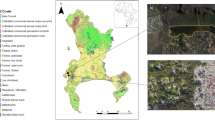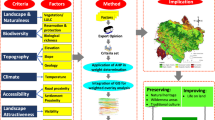Abstract
Excessive energy reliance and uncontrolled exploitation have caused significant environmental damage by prompting experts to advocate for active protection and conservation of Earth's habitats. Preserving urban wetlands is crucial for reducing natural disasters and maintaining city biodiversity. Therefore, this paper addresses the urgent need for active protection and conservation of urban wetlands due to the significant environmental damage caused by excessive energy reliance and uncontrolled exploitation. Establishing a complete urban wetland ecosystem is crucial to ensure the long-term viability of these fragile ecological environments. Using big data and the analytic hierarchy process (AHP), this study proposes a method to evaluate the plant landscape quality of Dongpu National Wetland Park in Luyang, Anhui, China. The proposed approach assesses and prioritizes urban wetland park landscapes by considering important ecological variables such as plant species diversity and wetland water ecology. Expert assessments generate a valid judgment matrix and assign weights to each evaluation index by providing insights into the influence of indicators on the park landscape. Demographic data analysis, including age, gender, education, and occupation, is considered to understand preferences. Based on the results of the evaluation, ten sample plots of Dongpu National Wetland Park in Luyang, Anhui, were classified into four grades (Grade I > 13.5; Grade II > 12–13.5; Grade III > 10.5–12; Grade IV 10.5), with Grades 1–3 accounting for 90% of the total. The evaluation scores confirm the visually appealing plant landscape of the park, with notable locations such as the main entrance, Huxin Square, and Yingying Road standing out for their lush vegetation and distinct ecological characteristics. This study outperforms previous research using a complete evaluation model and the AHP approach, allowing for a systematic assessment of the landscape quality of urban wetland parks. This localized research captures unique biological traits and gives significant insights into park management by concentrating on Dongpu National Wetland Park in Luyang, Anhui, China.









Similar content being viewed by others
Data availability
Enquiries about data availability should be directed to the authors.
References
Ali M, Yin B, Kunar A, Sheikh AM et al (2020) Reduction of multiplications in convolutional neural networks. In: 2020 39th Chinese control conference (CCC). IEEE, pp 7406–7411. https://doi.org/10.23919/CCC50068.2020.9188843
Aslam MS, Dai X, Hou J, Li Q, Ullah R, Ni Z, Liu Y (2020) Reliable control design for composite-driven scheme based on delay networked T–S fuzzy system. Int J Robust Nonlinear Control 30(4):1622–1642
Aslam MS, Tiwari P, Pandey HM, Band SS (2022) Observer-based control for a new stochastic maximum power point tracking for photovoltaic systems with networked control system. IEEE Trans Fuzzy Syst
Aslam MS, Tiwari P, Pandey HM, Band SS, El Sayed H (2023) A delayed Takagi–Sugeno fuzzy control approach with uncertain measurements using an extended sliding mode observer. Inf Sci 643:119204
Bilal H, Yin B, Kumar A, Ali M, Zhang J, Yao J (2023) Jerk-bounded trajectory planning for rotary flexible joint manipulator: an experimental approach. Soft Comput 27(7):4029–4039. https://doi.org/10.1007/s00500-023-07923-5
Chen T (2020) From the perspective of opera music, “sense reason with emotion, only in peony”—a preliminary study on kunqu opera “The peony pavilion sweet dream in the garden.” Destech Trans Soc Sci Educ Hum Sci. https://doi.org/10.12783/dtssehs/ssme2019/34830
Chen J, Zhang Y, Chen Z, Nie Z (2015) Improving assessment of groundwater sustainability with analytic hierarchy process and information entropy method: a case study of the Hohhot Plain, China. Environ Earth Sci 73:2353–2363
Chen Y, Chen Z, Guo D, Zhao Z, Lin T, Zhang C (2022) Underground space use of urban built-up areas in the central city of Nanjing: insight based on a dynamic population distribution. Undergr Space 7(5):748–766
Cheng B, Zhu D, Zhao S, Chen J (2016) Situation-aware IoT service coordination using the event-driven SOA paradigm. IEEE Trans Netw Serv Manag 13(2):349–361
Ding X, Chong X, Bao Z, Xue Y, Zhang S (2017) Fuzzy comprehensive assessment method based on the entropy weight method and its application in the water environmental safety evaluation of the Heshangshan drinking water source area, three gorges reservoir area. China Water 9(5):329
Hanford JK, Webb CE, Hochuli DF (2020) Management of urban wetlands for conservation can reduce aquatic biodiversity and increase mosquito risk. J Appl Ecol 57(4):794–805
He H, Tuo S, Lei K, Gao A (2023) Assessing quality tourism development in China: an analysis based on the degree of mismatch and its influencing factors. Environ Dev Sustain 1–28
Kumar A, Shaikh AM, Li Y et al (2021) Pruning filters with L1-norm and capped L1-norm for CNN compression. Appl Intell 51:1152–1160. https://doi.org/10.1007/s10489-020-01894-y
Li S, Shen J, Sun F, Jia Y, Han H (2022) Quantitative evaluation of ecological compensation policies for the watershed in China: based on the improved policy modeling consistency index. Environ Sci Pollut Res 29(44):66659–66674
Li L, Wu X, Kong M, Liu J, Zhang J (2023a) Quantitatively Interpreting residents happiness prediction by considering factor–factor interactions. IEEE Trans Comput Soc Syst
Li W, Wang C, Liu H, Wang W, Sun R, Li M, Shi Y, Zhu D, Du W, Ma L, Fu S (2023b) Fine root biomass and morphology in a temperate forest are influenced more by canopy water addition than by canopy nitrogen addition. Front Ecol Evol 11:1132248
Liu W, Guo Z, Jiang B, Lu F, Wang H, Wang D, Zhang M, Cui L (2020) Improving wetland ecosystem health in China. Ecol Ind 113:106184
Liu X, Li Z, Fu X, Yin Z, Liu M, Yin L, Zheng W (2023) Monitoring house vacancy dynamics in the Pearl River Delta region: a method based on NPP-VIIRS night-time light remote sensing images. Land 12(4):831
Mai X, Zhong H, Wen J, Nie K, Zhou S, Luo X (2018) The vernacular architecture in the process of rapid post-disaster reconstruction—a case study of Lixian County, Sichuan Province. Front Manag Res. https://doi.org/10.22606/fmr.2018.24006
Mitsch WJ (2005) Wetland creation, restoration, and conservation: a wetland invitational at the Olentangy River Wetland Research Park. Ecol Eng 24(4):243–251. https://doi.org/10.1016/j.ecoleng.2005.02.006
Pan M, Hu T, Zhan J, Hao Y, Li X, Zhang L (2023) Unveiling spatiotemporal dynamics and factors influencing the provision of urban wetland ecosystem services using high-resolution images. Ecol Ind 151:110305
Qiao G, Song H, Prideaux B, Huang SS (2023) The “unseen” tourism: travel experience of people with visual impairment. Ann Tour Res 99:103542
Qin Y, Li Z, Ding J, Zhao F, Meng M (2023) Automatic optimization model of transmission line based on GIS and genetic algorithm. Array 17:100266
Sanderson J, Harris LD (2020) The ecology in landscape ecology. Landsc Ecol. https://doi.org/10.1201/9780429148996-7
Shen Y, Ding N, Zheng HT, Li Y, Yang M (2020) Modeling relation paths for knowledge graph completion. IEEE Trans Knowl Data Eng 33(11):3607–3617
Tan X, Lin J, Xu K, Chen P, Ma L, Lau RWH (2023) Mirror detection with the visual chirality cue. IEEE Trans Pattern Anal Mach Intell 45(3):3492–3504
Wang L, Zhai Q, Yin B et al (2019) Second-order convolutional network for crowd counting. In: Proceedings of SPIE 11198, fourth international workshop on pattern recognition, 111980T (31 July 2019). https://doi.org/10.1117/12.2540362
Wang S, Palazzo E (2021) Sponge City and social equity: impact assessment of urban stormwater management in Baicheng City, China. Urban Clim 37:100829
Wang H, Liu Y, Yang Y, Fang Y, Luo S, Cheng H, Wang A (2022) Element sulfur-based autotrophic denitrification constructed wetland as an efficient approach for nitrogen removal from low C/N wastewater. Water Res 226:119258
Wan Y, Wan X (2023) Ecological landscape environmental optimization design for environmental protection under economical environment: Lake Wetland ecological landscape design. Int J Environ Sci Technol 8:1–12
Yao W, Guo Y, Wu Y, Guo J (2017) Experimental validation of fuzzy PID control of flexible joint system in presence of uncertainties. In: 2017 36th Chinese Control conference (CCC). IEEE, pp 4192–4197. https://doi.org/10.23919/ChiCC.2017.8028015
Yin B, Aslam MS et al (2023) A practical study of active disturbance rejection control for rotary flexible joint robot manipulator. Soft Comput 27:4987–5001. https://doi.org/10.1007/s00500-023-08026-x
Yin B, Khan J, Wang L, Zhang J, Kumar A (2019) Real-time lane detection and tracking for advanced driver assistance systems. In: 2019 Chinese control conference (CCC). IEEE, pp 6772–6777. https://doi.org/10.23919/ChiCC.2019.8866334
Zhang T, Song B, Han G, Zhao H, Hu Q, Zhao Y, Liu H (2023a) Effects of coastal wetland reclamation on soil organic carbon, total nitrogen, and total phosphorus in China: a meta-analysis. Land Degrad Dev
Zhang J, Yang Z, Sun Y, Xu Z, Hui T, Guo P (2023b) Experiencing urban forests to mitigate negative emotions of people exposed to seasonal PM2.5 in Northeast China. J for Res 8:1–17
Zhou X, Sun K, Wang J, Zhao J, Feng C, Yang Y, Zhou W (2023) Computer vision enabled building digital twin using building information model. IEEE Trans Ind Inf 19(3):2684–2692
Funding
This study was funded by Research Team on Cultural Resources and Artistic Expression of Traditional Folk Houses in Lijiang River Basin, Collaborative Innovation Group of Lijiang Culture Research Institute: 20180430.
Author information
Authors and Affiliations
Corresponding author
Ethics declarations
Conflict of interest
The authors have no relevant financial or non-financial interests to disclose. The authors declare that they have no conflict of interest.
Ethical approval
This article does not contain any study with human participants or animals performed by the authors.
Additional information
Publisher's Note
Springer Nature remains neutral with regard to jurisdictional claims in published maps and institutional affiliations.
Rights and permissions
Springer Nature or its licensor (e.g. a society or other partner) holds exclusive rights to this article under a publishing agreement with the author(s) or other rightsholder(s); author self-archiving of the accepted manuscript version of this article is solely governed by the terms of such publishing agreement and applicable law.
About this article
Cite this article
Lu, C. Evaluating urban ecological wetland parks using big data analytics and art vision. Soft Comput 27, 14451–14467 (2023). https://doi.org/10.1007/s00500-023-09036-5
Accepted:
Published:
Issue Date:
DOI: https://doi.org/10.1007/s00500-023-09036-5




